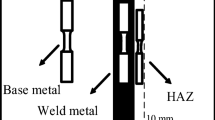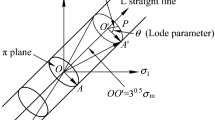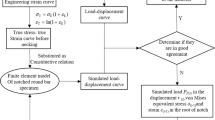Abstract
The ultra-low cycle fatigue (ULCF) fracture initiation caused by cyclic large plastic strain in structural steels is often the governing limit state in steel structures when subjected to strong earthquake actions. Based on the author’s previous work, this paper presents the improved cyclic void growth model (CVGM) and degraded significant plastic strain (DSPS) model considering the dependence of cyclic damage degradation parameters on stress triaxiality. To this end, tests on circular notched specimens and coupon specimens made of Q345qC steel were conducted, and scanning electron microscopy studies were performed on fracture surfaces of specimens, analysis results of which show that the ULCF fracture of Q345qC steel exhibits the typical behaviour of “void nucleation, growth, and coalescence.” The cyclic damage degradation parameters of CVGM and DSPS model were calibrated at different stress triaxialities based on experimental results of specimens and complementary finite element analysis, and empirical formulas were subsequently established between cyclic damage degradation parameters and stress triaxiality. Finally, detailed finite element analysis results demonstrate that the improved CVGM and DSPS model can predict ULCF fracture behaviour with higher accuracy in comparison with original models.
















Similar content being viewed by others
References
Anderson, T. L. (2005). Fracture mechanics: Fundamentals and applications. Boca Raton: CRC.
Baiguera, M., Vasdravellis, G., & Karavasilis, T. L. (2019). Ultralow cycle fatigue tests and fracture prediction models for duplex stainless-steel devices of high seismic performance braced frames. Journal of Structural Engineering ASCE, 145(1), 04018230.
Barsoum, I., Faleskog, J., & Pingle, S. (2011). The influence of the lode parameter on ductile failure strain in steel. Procedia Engineering, 10, 69–75.
Bron, F., Besson, J., & Pineau, A. (2004). Ductile rupture in thin sheets of two grades of 2024 aluminum alloy. Material Science Engineering A, 380(1–2), 356–364.
Chang, X., Yang, L., Zong, L., et al. (2019). Study on cyclic constitutive model and ultra low cycle fracture prediction model of duplex stainless steel. Journal of Construction Steel Research, 152, 105–116.
Danas, K., & Ponte, C. (2012). Influence of the Lode parameter and the stress triaxiality on the failure of elasto-plastic porous materials. International journal of Solids and Structures, 49, 1325–1342.
Fell, B.V., Kanvinde, A.M., & Deierlein, G.G. (2010). Large-scale testing and simulation of earthquake-induced ultra low cycle Fatigue in bracing members subjected to cyclic inelastic buckling. Blume Center TR 172, Stanford, CA, USA: Stanford University.
Ge, H. B., Ohashi, M., & Tajima, R. (2007). Experimental study on ductile crack initiation and its propagation in steel bridge piers of thick-walled box sections. Journal of Structural Engineering JSCE, 53, 493–502. ((In Japanese)).
Ge, H. B., & Kang, L. (2012). A damage index-based evaluation method for predicting the ductile crack initiation in steel structures. Journal of Earthquake Engineering, 16, 623–643.
Ge, H. B., Kang, L., & Tsumura, Y. (2013). Extremely low-cycle fatigue tests of thick-walled steel bridge piers. Journal of Bridge Engineering ASCE, 18, 858–870.
Han, Q., Jiang, K. J., Wen, J. N., et al. (2019). Micromechanical Fracture Models of Q345 Steel and Its Weld. Journal of Material in Civil Engineering., 31(11), 04019268.
Huang, X. W., Tong, L. W., Zhou, F., & Chen, Y. Y. (2013). Prediction of fracture behavior of beam-to-column welded joints using micromechanics damage model. Journal of Construction Steel Research, 85, 60–72.
Kanvinde, A.M., & Deierlein, G.G. (2004). Micromechanical Simulation of Earthquake-Induced Fracture in Steel Structures. Blume Center TR 145, Stanford, CA, USA: Stanford University.
Kanvinde, A. M., & Deierlein, G. G. (2006). Void growth model and stress modified critical strain model to predict ductile fracture in structural steels. Journal of Structural Engineering ASCE, 132(12), 1907–1918.
Kanvinde, A. M., & Deierlein, G. G. (2007). Cyclic void growth model to assess ductile fracture initiation in structural steels due to ultra low cycle fatigue. Journal of Engineering Mechanics ASCE, 133(6), 701–712.
Kiran, R., & Khandelwal, K. A. (2014). A triaxiality and Lode parameter dependent ductile fracture criterion. Engineering Fracture Mechanics, 128, 121–138.
Kuwamura, H., & Yamamoto, K. (1997). Ductile crack as trigger of brittle fracture in steel. Journal of Structural Engineering ASCE, 123, 729–735.
Lemaitre, J., & Chaboche, J. L. (1990). Mechanics of Solid Materials. UK: Cambridge University Press.
Liao, F.F. (2012). Study on micromechanical fracture criteria of structural steels and its applications to ductile fracture prediction of connections. PhD thesis, Tongji University, Shanghai, China. (in chinese).
Liao, Y.H. (2018). Research on ultra low cycle fatigue properties and fracture mechanism of steel bridge welded joint. Master’s Thesis, Zhejiang University, Hangzhou, China. (in chinese).
Liu, X.Y. (2015). Investigations on fracture behaviours of high strength steel materials and connections based on micromechanical models. PhD thesis, Tsinghua University, Beijing, China (in chinese).
Li, S. L., Xie, X., & Liao, Y. H. (2019). Improvement of cyclic void growth model for ultra-low cycle fatigue prediction of steel bridge Piers. Materials, 12, 1615.
McClintock, F. A. (1968). A criterion for ductile fracture by the growth of holes. Journal of Applied science, 35(2), 363–371.
Miller, D. K. (1998). Lessons learned from the Northridge earthquake. Engineering Structctures, 20, 249–260.
Myers, A.T., Deierlein, G.G., Kanvinde, A.M. (2009). Testing and probabilistic simulation of ductile fracture initiation in structural steel components and weldments. Blume Center TR 170, Stanford, CA, USA: Stanford University.
Nakashima, M., & Inoue, K. (1998). Classification of damage to steel buildings observed in the 1995 Hyogoken-Nanbu earthquake. Engineering Structctures, 20, 271–281.
Rice, J. R., & Tracey, D. M. (1969). On the ductile enlargement of voids in triaxial stress fields. Journal of the Mechanics and Physics of Solids, 17, 201–217.
Smith, C.M., Deierlein, G.G., & Kanvinde, A.M. (2014). A stress-weighted damage model for ductile fracture initiation in structural steel under cyclic loading and generalized stress states. Blume Center TR 187, Stanford, CA, USA: Stanford University.
Subcommittee on Investigation of Seismic Damage of Steel Structure, (2000). Investigation of causes of damage to steel structure on Hanshin-Awaji earthquake disaster. Proceedings of JSCE 64 17 30 (in japanese).
Tateishi, K., Chen, T., & Hanji, T. (2008). Extremely low cycle fatigue assessment method for un-stiffened cantilever steel columns. Doboku Gakkai Ronbunshuu A., 64, 288–296.
Tateishi, K., Hanji, T., & Minami, K. (2007). A prediction model for extremely low cycle fatigue strength of structural steel. International journal of fatigue, 29, 887–896.
Tong, L. W., Huang, X. W., Zhou, F., & Chen, Y. Y. (2016). Experimental and numerical investigations on extremely-low-cycle fatigue fracture behavior of steel welded joints. Journal of Construction Steel Research, 119, 98–112.
Wen, H. J., & Mahmoud, H. (2016). New model for ductile fracture of metal alloys.II: Reverse loading. Journal of Engineering Mechanics ASCE, 142(2), 04015089.
Xing, J. H., Guo, C. L., Li, Y. Y., & Chen, A. G. (2017). Damage coefficient identification of micromechanical fracture prediction models for steel Q235B. Journal of Harbin institute of technology, 49(5), 184–188. ((In Chinese)).
Xie, X., Zhuge, H. Q., Tang, Z. Z., Wang, T., & Liao, Y. H. (2018). Damage characteristics of thin-walled steel arch bridges subjected to in-plane earthquake action. Journal of Construction Steel Research, 151, 70–82.
Xue, L. (2008). A unified expression for low cycle fatigue and extremely low cycle fatigue and its implication for monotonic loading. International journal of fatigue, 30, 1691–1698.
Yin, F., Yang, L., Zong, L., Liu, X. Y., et al. (2018). Ultra-low Cycle Fatigue Fracture of High-Strength Steel Q460C and Its Weld. Journal of Materials in Civil Engineering ASCE, 30(11), 04018280.
Yin, F., Yang, L., Wang, M., et al. (2019a). Study on ultra-low cycle fatigue behavior of austenitic stainless steel. Thin-walled Structures, 143, 106205.
Yin, Y., Li, S., Han, Q. H., et al. (2019b). Calibration and verification of cyclic void growth model for G20Mn5QT cast steel. Engineering Fracture Mechanics, 206, 310–329.
Zhou, H., Wang, Y. Q., Shi, Y. J., Xiong, J., & Yang, L. (2013). Extremely low cycle fatigue prediction of steel beam-to-column connection by using a micro-mechanics based fracture model. International journal of fatigue, 48, 90–100.
Acknowledgements
The study described in this paper was supported by the Natural Science Foundation of China (51878606). Much appreciation is given to Xiaojing Cai for experimental support.
Author information
Authors and Affiliations
Corresponding author
Additional information
Publisher's Note
Springer Nature remains neutral with regard to jurisdictional claims in published maps and institutional affiliations.
Rights and permissions
About this article
Cite this article
Li, S., Xie, X., Tian, Q. et al. Improved Ultra-Low Cycle Fatigue Fracture Models for Structural Steels Considering the Dependence of Cyclic Damage Degradation Parameters on Stress Triaxiality. Int J Steel Struct 21, 329–348 (2021). https://doi.org/10.1007/s13296-020-00441-2
Received:
Accepted:
Published:
Issue Date:
DOI: https://doi.org/10.1007/s13296-020-00441-2




